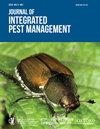Grower perceptions and adoption of IPM and non-Bt refuge in field corn: a survey in North and South Carolina
IF 2.7
3区 农林科学
Q1 ENTOMOLOGY
引用次数: 0
Abstract
Production of field corn in the southeastern United States is often impacted by a number of insect pests. However, surveys to assess stakeholder perception of the relative importance of insect pests and adopted management decisions for these pests have not been extensively reported in the region. A survey was conducted in North and South Carolina to address deficiencies in our knowledge about how corn producers perceive insect pests, implement management and insect resistance strategies, and understand and implement integrated pest management (IPM). The survey indicated that stink bugs (Hemiptera: Pentatomidae) and corn earworm, Helicoverpa zea (Boddie) (Lepidoptera: Noctuidae), were the most commonly managed insect pests in field corn. For transgenic corn expressing insecticidal toxins from Bacillus thuringiensis (Bt) (Berliner), the rate of resistance management (i.e., planting of non-Bt corn refuge) implemented (59%) by growers was higher than previously reported. The majority of grower respondents identified ear development as the most critical corn growth stage for managing stink bugs (52%), with the most commonly reported management strategy being applications of insecticide at the economic threshold. Growers also reported understanding the concepts of IPM and implementing it in field corn. Assessing the adoption of preventative approaches, such as Bt corn and insecticide seed treatments, and strategies to manage insect resistance, in the case of Bt corn in particular, is critical for tailoring research and Extension efforts to protect the durability of these management tactics.大田玉米种植者对 IPM 和非 Bt 避虫措施的看法和采用情况:在北卡罗来纳州和南卡罗来纳州进行的一项调查
美国东南部的大田玉米生产经常受到一些虫害的影响。然而,该地区尚未广泛报道过通过调查来评估利益相关者对害虫相对重要性的认识以及针对这些害虫所采取的管理决策。我们在北卡罗来纳州和南卡罗来纳州进行了一项调查,以解决我们对玉米生产者如何看待虫害、如何实施管理和抗虫策略以及如何理解和实施虫害综合防治 (IPM) 的认识不足的问题。调查表明,蝽象(半翅目:Pentatomidae)和玉米穗虫 Helicoverpa zea (Boddie)(鳞翅目:Noctuidae)是大田玉米中最常见的害虫。对于表达苏云金芽孢杆菌(Bt)(Berliner)杀虫毒素的转基因玉米,种植者实施抗性管理(即种植非 Bt 玉米避难所)的比例(59%)高于之前的报告。大多数受访种植者认为,穗发育期是管理蝽象最关键的玉米生长阶段(52%),最常报告的管理策略是在经济临界点施用杀虫剂。种植者还表示了解虫害综合防治的概念,并在大田玉米中加以实施。评估预防性方法(如 Bt 玉米和杀虫剂种子处理)的采用情况,以及管理昆虫抗药性的策略(尤其是 Bt 玉米),对于调整研究和推广工作以保护这些管理策略的持久性至关重要。
本文章由计算机程序翻译,如有差异,请以英文原文为准。
求助全文
约1分钟内获得全文
求助全文
来源期刊

Journal of Integrated Pest Management
Agricultural and Biological Sciences-Insect Science
CiteScore
5.80
自引率
3.60%
发文量
24
审稿时长
25 weeks
期刊介绍:
Journal of Integrated Pest Management is an open access, peer-reviewed, extension journal covering the field of integrated pest management. The Editors-in-Chief are Dr. Marlin E. Rice (formerly with Iowa State University) and Dr. Kevin L. Steffey (formerly with the University of Illinois). The journal is multi-disciplinary in scope, publishing articles in all pest management disciplines, including entomology, nematology, plant pathology, weed science, and other subject areas.
 求助内容:
求助内容: 应助结果提醒方式:
应助结果提醒方式:


